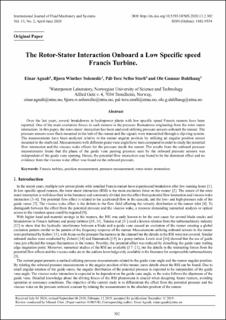| dc.contributor.author | Agnalt, Einar | |
| dc.contributor.author | Solemslie, Bjørn Winther | |
| dc.contributor.author | Storli, Pål-Tore Selbo | |
| dc.contributor.author | Dahlhaug, Ole Gunnar | |
| dc.date.accessioned | 2020-04-28T18:21:15Z | |
| dc.date.available | 2020-04-28T18:21:15Z | |
| dc.date.created | 2020-04-28T11:40:50Z | |
| dc.date.issued | 2020 | |
| dc.identifier.citation | International Journal of Fluid Machinery and Systems. 2020, 13 (2), 302-309. | en_US |
| dc.identifier.issn | 1882-9554 | |
| dc.identifier.uri | https://hdl.handle.net/11250/2652831 | |
| dc.description.abstract | Over the last years, several breakdowns in hydropower plants with low specific speed Francis runners have been reported. One of the main excitation forces in such runners is the pressure fluctuations originating from the rotor stator interaction. In this paper, the rotor-stator interaction has been analyzed utilizing pressure sensors onboard the runner. The pressure sensors were flush mounted in the hub of the runner and the signals were transmitted through a slip-ring system. The measurements have been analyzed relative to the runner angular position by utilizing an angular position sensor mounted to the shaft end. Measurements with different guide vane angle have been compared in order to study the potential flow interaction and the viscous wake effects for the pressure inside the runner. The results from the onboard pressure measurements found that the phase of the guide vane passing pressure seen by the onboard pressure sensors was independent of the guide vane opening. Hence, the potential flow interaction was found to be the dominant effect and no evidence from the viscous wake effect was found on the onboard pressure. | en_US |
| dc.language.iso | eng | en_US |
| dc.publisher | International Association of Hydraulic Engineering and Research | en_US |
| dc.relation.uri | https://www.ntnu.edu/nvks/hifrancis | |
| dc.title | The Rotor-Stator Interaction Onboard a Low Specific speed Francis Turbine | en_US |
| dc.type | Journal article | en_US |
| dc.type | Peer reviewed | en_US |
| dc.description.version | publishedVersion | en_US |
| dc.source.pagenumber | 302-309 | en_US |
| dc.source.volume | 13 | en_US |
| dc.source.journal | International Journal of Fluid Machinery and Systems | en_US |
| dc.source.issue | 2 | en_US |
| dc.identifier.doi | 10.5293/IJFMS.2020.13.2.302 | |
| dc.identifier.cristin | 1808438 | |
| dc.relation.project | Norges forskningsråd: 254987 | en_US |
| cristin.ispublished | true | |
| cristin.fulltext | original | |
| cristin.qualitycode | 1 | |
